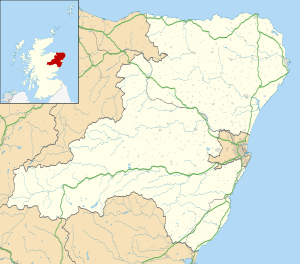Durris Castle facts for kids
Quick facts for kids Durris Castle |
|
|---|---|
| Aberdeenshire, Scotland | |
| Coordinates | 57°03′43″N 2°21′54″W / 57.0619°N 2.36495°W |
| Site information | |
| Open to the public |
Unknown |
| Condition | Ruin |
| Site history | |
| Demolished | 17th century |
Durris Castle, sometimes called the House of Dores, was once an important royal home in Scotland. It stood on the southern bank of the River Dee in Aberdeenshire. This castle was very important because it guarded a key pathway called the Crynes Corse Mounth trackway.
Contents
Discovering Durris Castle's Past
A Look Back at Durris Castle
Durris Castle was built a long time ago, at least by the 1200s. It was a type of castle called a motte and bailey. This means it had a large earth mound (the motte) with a wooden tower on top. Around the mound was a protected yard (the bailey).
Many important people visited or lived at Durris Castle. King Alexander III of Scotland stayed there. Records from that time show that repairs were made to the castle.
Royal Visits and Ownership Changes
In 1296, King Edward I of England stayed at Durris Castle for one night. This was during his invasion of Scotland. Later, King Robert I of Scotland gave Durris Castle to the Fraser family. Then, King David II of Scotland made it into a special area called a barony. This gave the Fraser family more control over the land.
The Castle's End
Sadly, Durris Castle did not last forever. In 1645, a military leader called the Marquis of Montrose burned the castle down. After that, it was never rebuilt.
What Remains Today
Today, you won't find any castle buildings at Durris. However, the hill where it once stood is still there. This hill is about 7 metres (23 feet) high and is called Castle Hill. The top of the hill is flat, measuring about 41 metres (135 feet) by 30 metres (98 feet). It looks like the sides of the hill might have been made steeper by people long ago. On the western side, you can still see signs of a ditch, which was probably a moat around the castle.


